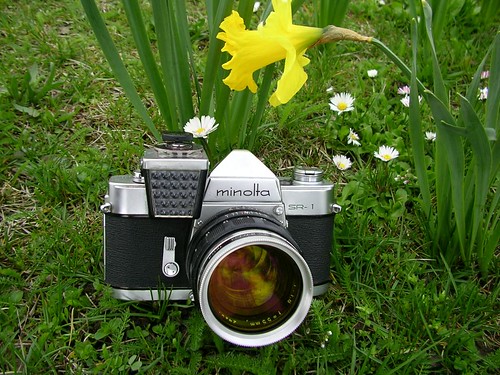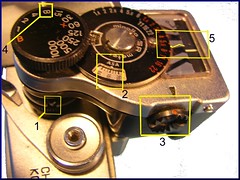Difference between revisions of "Minolta SR-1"
| Line 2: | Line 2: | ||
The '''Minolta SR-1''' was the second model of [[Minolta]]'s first series of single lens reflex camera bodies. It was a purely mechanical camera. A 6-lens 55mm-Rokkor had been the standard lens for that camera. When it had been introduced in 1959 several other Minolta [[Rokkor]] lenses had already been available, from 35mm upto 600mm focus. At least 5 different improved versions of the SR-1 had been brought to the market in the following 3 years. | The '''Minolta SR-1''' was the second model of [[Minolta]]'s first series of single lens reflex camera bodies. It was a purely mechanical camera. A 6-lens 55mm-Rokkor had been the standard lens for that camera. When it had been introduced in 1959 several other Minolta [[Rokkor]] lenses had already been available, from 35mm upto 600mm focus. At least 5 different improved versions of the SR-1 had been brought to the market in the following 3 years. | ||
| − | In 1961 a holder ('''1''') for an additional selenium exposure meter had been added to the camera's design. The applicable meters for the SR-1 were connected mechanically with the shutter-speed preselector of the camera: The little bolt ('''2''') on camera's preselector connected to the clutch ('''3''') of the meter's shutter-speed preselector. When the correct ASA-value of the film and the exposure time had been preselected on the meter, the measuring instrument's scale directly showed the aperture that the user had to select at the lens. | + | In 1961 a holder ('''1''') for an additional selenium exposure meter had been added to the camera's design. The applicable meters for the SR-1 were connected mechanically with the shutter-speed preselector of the camera: The little bolt ('''2''') on the camera's preselector was connected to the clutch ('''3''') of the meter's shutter-speed preselector. When the correct ASA-value of the film and the exposure time had been preselected on the meter, the measuring instrument's scale directly showed the aperture that the user had to select at the lens. |
Another optional part of the SR-1 was the flash shoe. | Another optional part of the SR-1 was the flash shoe. | ||
Revision as of 22:29, 1 May 2006

The Minolta SR-1 was the second model of Minolta's first series of single lens reflex camera bodies. It was a purely mechanical camera. A 6-lens 55mm-Rokkor had been the standard lens for that camera. When it had been introduced in 1959 several other Minolta Rokkor lenses had already been available, from 35mm upto 600mm focus. At least 5 different improved versions of the SR-1 had been brought to the market in the following 3 years.
In 1961 a holder (1) for an additional selenium exposure meter had been added to the camera's design. The applicable meters for the SR-1 were connected mechanically with the shutter-speed preselector of the camera: The little bolt (2) on the camera's preselector was connected to the clutch (3) of the meter's shutter-speed preselector. When the correct ASA-value of the film and the exposure time had been preselected on the meter, the measuring instrument's scale directly showed the aperture that the user had to select at the lens.
Another optional part of the SR-1 was the flash shoe.
The SR-1's predecessor had been the Minolta SR-2, the first single lens reflex camera for Minolta's SR-Rokkor-lenses, which also had been the first camera ever combining several typical features of modern SLR-cameras. Later the SR-3 took the place of the SR-2. Both cameras had slightly faster exposure mechanics than the SR-1. In 1962 the first Minolta SLR camera with inbuilt meter had been introduced as last member of the SR-n-family: The SR-7. One of the SR1-models, the SR-1 (V), had been the base on which the Minolta SR-T 101 had been developped.

| metering |
|---|
 Metering was simple: The meter had to be put into its holder and its shutter-speed selector's clutch connected correctly to the camera's selector's bolt(1). Then the right ASA film speed had to be selected on the meter (2), and the meter mode to be chosen (3). Shutter speed had to be chosen for each exposure with the meter's selector (4). The correct aperture had been shown by the meter (5). Finally the aperture had to be selected at the lens manually. |